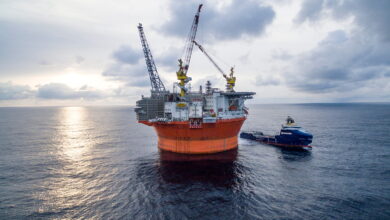MPD deployment from floating rig positions Petrobras for ambitious campaign through 2017
By Katie Mazerov, contributing editor
A well abandonment, along with continued incidents of kicks and losses and nonproductive time (NPT), provided the impetus for Petrobras to embark on its first managed pressure drilling (MPD) operation from a floating rig for an exploratory well in the Santos Basin, setting the stage for future MPD endeavors in the region over the next four years. “Large formation losses, high pore pressure, a narrow operating window and a high risk of ballooning made this well particularly challenging for us. After we were unable to reach total depth (TD), we realized we needed to implement MPD to prevent further losses,” said Emmanuel Nogueira, petroleum engineer for Petrobras. In a presentation at the 2013 IADC/SPE Managed Pressure Drilling & Underbalanced Operations Conference & Exhibition in San Antonio on 17-18 April, Mr Nogueira and his Petrobras colleague Guilherme S. Vanni described the extensive planning, training, rig modifications and collaboration with multiple service providers that Petrobras undertook to launch the project.
The presentation also highlighted ongoing challenges in training and rig equipment, as Petrobras anticipates drilling at least 25 exploratory wells requiring MPD, and some development wells, in shallow, deepwater and ultra-deepwater fields in the Santos Basin between now and 2017.
In adopting the MPD strategy, Petrobras aims to reduce fluid gains and losses, mitigate problems associated with ballooning, increase rates of penetration, extend TD, reduce probability of drill string sticking, minimize formation damage and well stability problems and open up possibilities for automatically switching to pressurized mud cap drilling, Mr Nogueira said.
The project required a number of modifications to the fifth-generation semisubmersible, including retrofitting the riser and blowout preventer to accommodate rotating control devices (RCD). In designing the well, engineers selected a large-bore wellhead system and an 18-in. liner to run 13 5/8-in. casing without underreaming to drill the 12 ¼-in. and 8 1/2-in. sections of the well, using hydrostatically underbalanced (UB) fluid.
Petrobras initially devised an extensive pre-job planning scenario, including the development of 44 specific procedures for the MPD operations. “We got all the service companies together and formed a task force that held weekly meetings and monitored all the actions needed to complete a successful job in all well sections,” Mr Vanni said. These included development of casing and liner contingencies.
Training was another key issue and remains a significant concern going forward, he continued. “Today, we have a lot of new offshore rigs in Brazil and very inexperienced drilling crews. Some crews have just four or five years of experience. For this operation, we provided internal training and also engaged the service companies to provide hands-on training for the well design team and advanced training in MPD RCD technology for all the rig teams.” Alongside those efforts was development of standards and procedures for MPD and mud cap drilling (MCD) and a process of defining well control procedures. Discussions about well control using MPD for even the most minor influx remains an important priority.
Looking ahead, Petrobras anticipates having as many as six MPD rigs ready by mid-2014. But the company has ongoing concerns about the widespread implementation of MPD on offshore vessels as it relates to crew competency, the ability of service providers to conduct multiple simultaneous deepwater operations and a lack of MPD equipment on existing rigs. “For example, we have severe restrictions with upper riser equipment,” Mr Vanni noted. “Ninety-five percent of riser systems have restrictions for running assemblies for RCDs. This signals a need to modify existing rig equipment and find ways to implement or retrofit MPD equipment into existing rigs for efficiency.”
Acknowledging increasing adoption of MPD in the offshore sector, Mr Vanni emphasized the cost benefit of MPD over conventional drilling methods. “Between 2010 and 2012, Petrobras drilled 67 conventional wells, 29 of which had kicks or losses,” he said. “That translated to nearly 4,600 lost hours and 191 lost days, which is ultimately much more expensive than MPD.”




